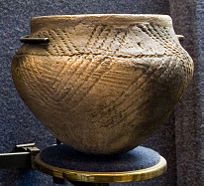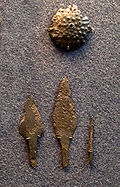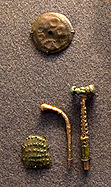
Yamna culture
Encyclopedia


Bronze Age
The Bronze Age is a period characterized by the use of copper and its alloy bronze as the chief hard materials in the manufacture of some implements and weapons. Chronologically, it stands between the Stone Age and Iron Age...
culture of the Southern Bug
Southern Bug
The Southern Bug, also called Southern Buh), is a river located in Ukraine. The source of the river is in the west of Ukraine, in the Volyn-Podillia Upland, about 145 km from the Polish border, and flows southeasterly into the Bug Estuary through the southern steppes...
/Dniester
Dniester
The Dniester is a river in Eastern Europe. It runs through Ukraine and Moldova and separates most of Moldova's territory from the breakaway de facto state of Transnistria.-Names:...
/Ural region (the Pontic steppe), dating to the 36th–23rd centuries BC. The name also appears in English as Pit Grave Culture or Ochre Grave Culture.
The culture was predominantly nomadic
Nomad
Nomadic people , commonly known as itinerants in modern-day contexts, are communities of people who move from one place to another, rather than settling permanently in one location. There are an estimated 30-40 million nomads in the world. Many cultures have traditionally been nomadic, but...
, with some agriculture
Agriculture
Agriculture is the cultivation of animals, plants, fungi and other life forms for food, fiber, and other products used to sustain life. Agriculture was the key implement in the rise of sedentary human civilization, whereby farming of domesticated species created food surpluses that nurtured the...
practiced near rivers and a few hillforts.
The Yamna culture was preceded by the Sredny Stog culture
Sredny Stog culture
The Sredny Stog culture dates from the 4500-3500 BC. It was situated just north of the Sea of Azov between the Dnieper and the Don...
, Khvalynsk culture
Khvalynsk culture
The Khvalynsk culture was an Eneolithic culture of the first half of the 5th millennium BC, discovered at Khvalynsk on the Volga in Saratov Oblast, Russia. The culture also is termed the Middle Eneolithic or Developed Eneolithic or Proto-kurgan...
and Dnieper-Donets culture
Dnieper-Donets culture
Dnieper-Donets culture, ca. 5th—4th millennium BC. A neolithic culture in the area north of the Black Sea/Sea of Azov between the Dnieper and Donets River.There are parallels with the contemporaneous Samara culture...
, while succeded by the Catacomb culture
Catacomb culture
The Catacomb culture, ca. 2800-2200 BC, refers to an early Bronze Age culture occupying essentially what is present-day Ukraine. It is seen more as a term covering several smaller related archaeological cultures....
and the Srubna culture
Srubna culture
The Srubna culture , was a Late Bronze Age culture. It is a successor to the Yamna culture, the Pit Grave culture and the Poltavka culture....
.
Characteristics
Characteristic for the culture are the inhumations in kurgans (tumuli) in pit graves with the dead body placed in a supine positionSupine position
The supine position is a position of the body: lying down with the face up, as opposed to the prone position, which is face down, sometimes with the hands behind the head or neck. When used in surgical procedures, it allows access to the peritoneal, thoracic and pericardial regions; as well as the...
with bent knees. The bodies were covered in ochre
Ochre
Ochre is the term for both a golden-yellow or light yellow brown color and for a form of earth pigment which produces the color. The pigment can also be used to create a reddish tint known as "red ochre". The more rarely used terms "purple ochre" and "brown ochre" also exist for variant hues...
. Multiple graves have been found in these kurgans, often as later insertions.
Significantly, animal grave offerings were made (cattle, sheep, goats and horse), a feature associated with Proto-Indo-Europeans
Proto-Indo-Europeans
The Proto-Indo-Europeans were the speakers of the Proto-Indo-European language , a reconstructed prehistoric language of Eurasia.Knowledge of them comes chiefly from the linguistic reconstruction, along with material evidence from archaeology and archaeogenetics...
(including Proto-Indo-Iranians).
The earliest remains in Eastern Europe
Europe
Europe is, by convention, one of the world's seven continents. Comprising the westernmost peninsula of Eurasia, Europe is generally 'divided' from Asia to its east by the watershed divides of the Ural and Caucasus Mountains, the Ural River, the Caspian and Black Seas, and the waterways connecting...
of a wheel
Wheel
A wheel is a device that allows heavy objects to be moved easily through rotating on an axle through its center, facilitating movement or transportation while supporting a load, or performing labor in machines. Common examples found in transport applications. A wheel, together with an axle,...
ed cart were found in the "Storozhova mohyla" kurgan
Kurgan
Kurgan is the Turkic term for a tumulus; mound of earth and stones raised over a grave or graves, originating with its use in Soviet archaeology, now widely used for tumuli in the context of Eastern European and Central Asian archaeology....
(Dnipropetrovsk
Dnipropetrovsk
Dnipropetrovsk or Dnepropetrovsk formerly Yekaterinoslav is Ukraine's third largest city with one million inhabitants. It is located southeast of Ukraine's capital Kiev on the Dnieper River, in the south-central region of the country...
, Ukraine
Ukraine
Ukraine is a country in Eastern Europe. It has an area of 603,628 km², making it the second largest contiguous country on the European continent, after Russia...
, excavated by Trenozhkin A.I.) associated with the Yamna culture.
Spread and identity
The Yamna culture is identified with the late Proto-Indo-EuropeansProto-Indo-Europeans
The Proto-Indo-Europeans were the speakers of the Proto-Indo-European language , a reconstructed prehistoric language of Eurasia.Knowledge of them comes chiefly from the linguistic reconstruction, along with material evidence from archaeology and archaeogenetics...
(PIE) in the Kurgan hypothesis
Kurgan hypothesis
The Kurgan hypothesis is one of the proposals about early Indo-European origins, which postulates that the people of an archaeological "Kurgan culture" in the Pontic steppe were the most likely speakers of the Proto-Indo-European language...
of Marija Gimbutas
Marija Gimbutas
Marija Gimbutas , was a Lithuanian-American archeologist known for her research into the Neolithic and Bronze Age cultures of "Old Europe", a term she introduced. Her works published between 1946 and 1971 introduced new views by combining traditional spadework with linguistics and mythological...
. It is one candidate for the Urheimat
Urheimat
Urheimat is a linguistic term denoting the original homeland of the speakers of a proto-language...
(homeland) of the Proto-Indo-European language
Proto-Indo-European language
The Proto-Indo-European language is the reconstructed common ancestor of the Indo-European languages, spoken by the Proto-Indo-Europeans...
, along with the preceding Sredny Stog culture
Sredny Stog culture
The Sredny Stog culture dates from the 4500-3500 BC. It was situated just north of the Sea of Azov between the Dnieper and the Don...
, now that archaeological evidence of the culture and its migrations has been closely tied to the evidence from linguistics.
Pavel Dolukhanov argues that the emergence of the Pit-Grave culture represents a social development of various local Bronze Age cultures, representing "an expression of social stratification and the emergence of chiefdom-type nomadic social structures", which in turn intensified inter-group contacts between essentially heterogeneous social groups.
It is said to have originated in the middle Volga based Khvalynsk culture
Khvalynsk culture
The Khvalynsk culture was an Eneolithic culture of the first half of the 5th millennium BC, discovered at Khvalynsk on the Volga in Saratov Oblast, Russia. The culture also is termed the Middle Eneolithic or Developed Eneolithic or Proto-kurgan...
and the middle Dnieper based Sredny Stog culture
Sredny Stog culture
The Sredny Stog culture dates from the 4500-3500 BC. It was situated just north of the Sea of Azov between the Dnieper and the Don...
. In its western range, it is succeeded by the Catacomb culture
Catacomb culture
The Catacomb culture, ca. 2800-2200 BC, refers to an early Bronze Age culture occupying essentially what is present-day Ukraine. It is seen more as a term covering several smaller related archaeological cultures....
; in the east, by the Poltavka culture
Poltavka culture
Poltavka culture, 2700—2100 BC, an early to middle Bronze Age archaeological culture of the middle Volga from about where the Don-Volga canal begins up to the Samara bend, with an easterly extension north of present Kazakhstan along the Samara River valley to somewhat west of Orenburg.It is...
and the Srubna culture
Srubna culture
The Srubna culture , was a Late Bronze Age culture. It is a successor to the Yamna culture, the Pit Grave culture and the Poltavka culture....
.
Artifacts
Hermitage Museum
The State Hermitage is a museum of art and culture in Saint Petersburg, Russia. One of the largest and oldest museums of the world, it was founded in 1764 by Catherine the Great and has been opened to the public since 1852. Its collections, of which only a small part is on permanent display,...
collections >




See also
- KurganKurganKurgan is the Turkic term for a tumulus; mound of earth and stones raised over a grave or graves, originating with its use in Soviet archaeology, now widely used for tumuli in the context of Eastern European and Central Asian archaeology....
- Kurgan stelaeKurgan stelaeKurgan stelae or Balbals are anthropomorphic stone stelae, images cut from stone, installed atop, within or around kurgans , in kurgan cemeteries, or in a double line extending from a kurgan...
- Cucuteni-Trypillian culture
- Vinča cultureVinca cultureThe Vinča culture is a Neolithic archaeological culture in Southeastern Europe, dated to the period 5500–4500 BCE. Named for its type site, Vinča-Belo Brdo, a large tell settlement discovered by Serbian archaeologist Miloje Vasić in 1908, it represents the material remains of a prehistoric society...
- Beaker cultureBeaker cultureThe Bell-Beaker culture , ca. 2400 – 1800 BC, is the term for a widely scattered cultural phenomenon of prehistoric western Europe starting in the late Neolithic or Chalcolithic running into the early Bronze Age...

